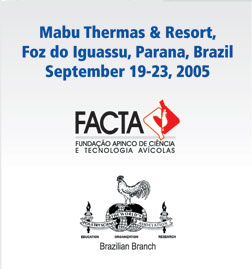Contributed
Papers: Oral Presentations
Vaccines
Effects
of dietary short chain fatty acids on experimentally
induced coccidiosis and necrotic enteritis in broilers
vaccinated against coccidiosis
S. Perrucci (1), G. Brajon (2),
G. Fichi (1), G. Rossi (3), M. Kang (4), F. Corrias
(2), A. Piazza (2), A. Buccioni (5), F. Petacchi (5),
G. Tosi (6), M. Antongiovanni (5)
(1) Dipartimento di Patologia Animale, Profilassi
ed Igiene degli Alimenti, University of Pisa (Italy);
(2) Istituto Zooprofilattico Sperimentale delle Regioni
Lazio e Toscana – Sezione di Firenze (Italy);
(3) Dipartimento di Scienze Veterinarie, University
of Camerino (Italy).
(4) Department of Veterinary Medicine, University
of Qinghai (China);
(5) Dipartimento di Scienze Zootecniche, University
of Florence (Italy).
(6) Istituto Zooprofilattico Sperimentale per La Lombardia
e l’Emilia Romagna – Sezione di Forlì
(Italy).
Corresponding author’s E-mail: perrucci@vet.unipi.it
Introduction
In the poultry industry, necrotic enteritis (NE) manifests
itself when a large Clostridium perfrigens (CP) colonization
coincides with significant damages to the gut epithelium,
often caused by coccidia. Since antibiotics and coccidiostats
are to be banned in the European Union next year,
short chain fatty acids (SCFA) could replace them.
Objective. The aim of the present work was to verify
the onset of experimentally induced NE in vaccinated
chickens (Paracox-5, sprayed in the hatchery), either
fed SCFA for 21 days only or avilamycin for 42 days.
Birds were orally challenged on day 21 with CP (5x105
CFU/ml) and Eimeria acervulina, maxima and tenella
(104; 103 and 5x103 oocysts, respectively). The groups
(40 chickens each) were: 1) control; 2) avilamycin,
10 ppm; 3) butyric triglyceride (BT), 0.2%; 4) BT,
0.2% + caprylic and capric triglycerides, 0.15% and
5) BT, 0.2% + free caprylic and capric acids, 0.1%.
From day 28 until day 42, three birds per group were
euthanised each week and their intestines examined
for coccidia, CP, NE lesions, and number of oocysts
for gram of faeces (OPG).
Main findings. All the examined birds presented NE
lesions after Eimeria spp. and CP. The lesion score
was higher in the first two weeks following infection,
and no mortality was recorded. The most severe lesions
were associated with a high degree of sub-epithelial/interstitial
coccidian colonization. Clostridia, when largely present,
were associated with necrotic material or into severely
damaged crypts. OPG resulted highest with avilamycin
at day 28.
Conclusions. Although vaccinated, all the birds developed
gut coccidian lesions and NE. Avilamycin was linked
with a high number of coccidian OPG. The birds fed
diet 4 had better live performances.
